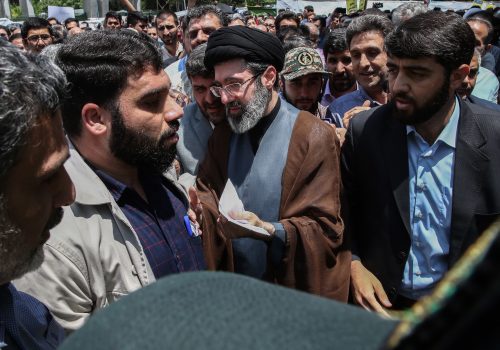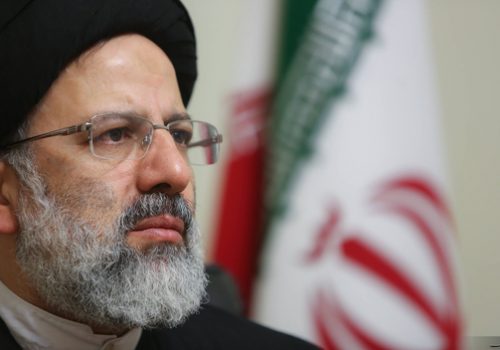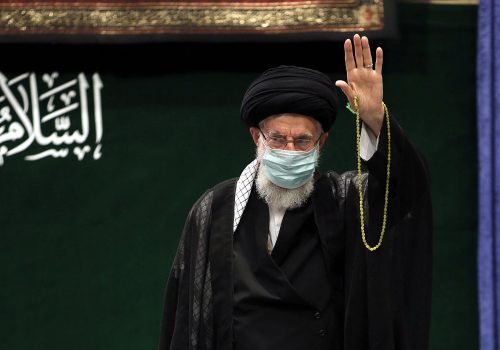Why Khamenei’s son is not the next radical modernizer in the Middle East
As protests in Iran reach their tenth month, there is widespread consensus—even among regime insiders—that the Islamic Republic is unstable beneath the surface and revolution could be on the horizon.
But the cohort of insiders that have reached this conclusion—mainly from the so-called “reformist” faction—believe there is still hope for the clerical system. During the peak of the anti-regime protests, Mohsen Ranai, a regime-affiliated economist close to the so-called reformist elites, wrote: “[In the absence of a] revolution from above… a revolution from below will naturally occur.” In other words, while the opportunity for “reform” has been lost, the possibility of a “revolution from above”—from the elites—still exists—so long as there’s not a people-led revolution from below. Such a “revolution,” they claim, would preserve the regime and limit bloodshed.
But what does “revolution from above” mean in the Islamic Republic? For more than thirty years, Supreme Leader Ayatollah Ali Khamenei has held absolute power in the clerical establishment. During his reign, the Islamic Republic became more ideological, totalitarian, and repressive.
This cohort of elites, who are still committed to the clerical regime, believe Khamenei is the biggest impediment to a “revolution from above” and, therefore, are banking on his evermore likely successor: his son, Mojtaba.
All experts, inside and outside of Iran, point exclusively to two hardline Islamist clerics to succeed Khamenei: incumbent President Ebrahim Raisi and Mojtaba Khamenei.
While Raisi—infamously known as the “Butcher of Tehran” for his role in the mass execution of political prisoners in 1988—has a proven track record that underscores he is anything but a radical reformer, not least in his current role in brutally suppressing Mahsa Amini protests that begun in September 2022, less is known about Khamenei’s son, who operates in the shadows.
It is precisely for this reason that this cohort of regime elites hope Mojtaba Khamenei can emerge as the next radical modernizer in the Middle East, mimicking those on the other side of the Persian Gulf and transforming the Islamic Republic from above—a view that may have found some resonance outside of Iran, per conversations we’ve had with policymakers and fellow analysts.
The transformation of Arab monarchies at the behest of their young modernizing leaders—such as Saudi Crown Prince Mohamed bin Salman—has revolutionized their countries, not least in the realms of cultural and societal liberalization. Even the sharpest critics of Arab monarchies would concede that the changes seen in the past few years have been akin to a “revolution from above.”
But can an ayatollah’s son do the same? The short answer is no. Three major indicators forecast why Mojtaba will be anything but a radical modernizer for Iran.
The first relates to Mojtaba’s background and personal experiences—factors that will have shaped his views and values. To be a transformational, modernizing leader, such an individual has to either have a modern education or, at the very least, be well-traveled and/or connected to the outside world. After all, one must experience the fruits of cultural and societal liberalization—and the modern world—to appreciate their worth.
Mojtaba Khamenei has done no such thing. The Supreme Leader’s son has not only had an extremely isolated and insular upbringing, but has yet to step outside Iran.
At seventeen, Mojtaba joined the Islamic Revolutionary Guard Corps (IRGC) and fought in the bloody eight-year Iran-Iraq War as part of the 27th Mohammad Rasulullah Division—a notoriously ideological unit. This contingent was founded by the IRGC’s Ahmad Motevaselian, a profoundly anti-Semitic individual and one of the founders of Lebanese Hezbollah. Under Mohammad Kowsari’s command, Mojtaba fought as part of the Habib Battalion, which was made up of the most radical right Islamists, most of whom would later form the core of the regime’s security and intelligence bodies.
Almost a decade after the conflict, in 1999, Mojtaba began his traditional clerical studies at the deeply conservative Qom Shia Seminary. His studies there would be overseen by his father’s closest and most extremist clerics, such as Ayatollah Mohammad Taqi Mesbah-Yazdi. A few years later, in 2002, Mesbah-Yazdi issued a fatwa calling for killings of Iranian youths who promoted “Western immorality” and engaged in extramarital affairs, which resulted in a string of murders by the IRGC’s paramilitary arm, the Basij, in the province of Kerman.
Following his studies in Qom, Mojtaba returned to Tehran to undertake a role at the Office of the Supreme Leader—the most powerful and securitized center of power in the Islamic Republic—under his father’s direct and close supervision. He even opted to take his father’s dars-e kharej class (Shia jurisprudence specialism classes) in the Office of Supreme Leader to become a mujtahid and achieve ayatollah clerical status. Over time, Khamenei, the elder, would train his son to lead his office—a role he maintains with an iron fist.
Mojtaba’s first taste of politics would come in 2005, when he led the electoral manipulation of the 2005 presidential elections in favor of hardline Basij member Mahmoud Ahmadinejad, despite complaints from other candidates. Since then, with his father’s full backing, Mojtaba has emerged as the man behind the curtain controlling the Office of the Supreme Leader, with heavy involvement in decision-making across the Islamic Republic.
Another indicator to consider relates to Mojtaba’s inner circle. As the old saying goes, “You can judge a man by the company he keeps”—this could not be clearer about Mojtaba. The inner ring of the Supreme Leader’s son includes the most ideologically extremist clerics among the next generation of regime elites, such as Mehdi Taeb, brother of the former IRGC Intelligence head who leads the hardline Ammar Headquarters; Alireza Panahian, an IRGC-affiliated extremist cleric who has a leading role in the IRGC’s indoctrination program; and Mohammad Qomi, head of the Islamic Propaganda Organization.
These extremist clerics and their militant followers have been at the forefront of the brutal violent crackdown against the grassroots cultural and societal liberalization of the Iranian population. They are also leading advocates of the militaristic doctrine of Mahdism, the most radical Islamist doctrine. Those who subscribe to this apocalyptic ideology believe the eradication of Israel will facilitate the return of the Twelfth divinely ordained Shia Imam, Mohammad al-Mahdi, whom Shia Muslims believe went into occultation in 874 AD. If Mojtaba attains the mantle after his father’s death, this so-called “ideologically pure” clique will be rewarded with senior elite positions of power and will have the ear of the new Supreme Leader.
Finally, what vision can be pieced together from the ayatollah’s son? Mojtaba has been a man of few words and has preferred to operate in the shadows. Nevertheless, actions tend to speak louder than words.
A leaked IRGC intelligence report reveals that Mojtaba Khamenei had a crucial role in commanding the violent suppression of Iranian civilians in the recent anti-regime protests. This IRGC report claims that, while Mojtaba conveyed his “appreciation” towards the regime’s security forces for neutralizing the nationwide protests, he also criticized the Basij for ignoring his consistent calls to be better equipped to suppress those on the streets.
This report is consistent with Mojtaba’s direct commanding role in confronting past anti-regime protests in Iran. During the 2009 post-election protests known as the Green Movement, regime insiders indicated that Mojtaba took complete control over coordinating IRGC’s Basij crackdown on protesters that were demanding greater liberalization. Based on accounts from the so-called “reformist faction” during the 2009 suppression, national security meetings were relocated to the Office of the Supreme Leader to be personally supervised by Mojtaba. It was precisely Mojtaba’s direct role in the violent suppression of protesters that resulted in popular slogans being directed at him, such as, “Mojtaba, we hope you die, so you never see the supreme leadership.”
Beyond this, it is known, like his father, that Mojtaba belongs to the radical Shia Islamist faction that subscribes to absolute clerical guardianship and its two core principles: domestic Islamization and exporting the Islamic Revolution.
While this may disappoint the cohort of elites like Ranai, who are banking on a “revolution from above,” the idea that Mojtaba will emerge as the next radical modernizer in the region is nothing but wishful thinking. In fact, from what is known so far, the ayatollah’s son will continue his father’s path, but perhaps with even more youthful energy, given his age of 54 years.
With that in mind, the past ten months have demonstrated that this revolution from below is ongoing. Instead of hedging bets on Mojtaba—a bet doomed to fail—the international focus should be on supporting the Iranian people—the real changemakers in this dynamic.
Saeid Golkar is an assistant professor in the Department of Political Science and Public Service at the University of Tennessee at Chattanooga and the author of Captive Society: The Basij Militia and Social Control in Iran. Follow him on Twitter: @SaeidGolkar.
Kasra Aarabi is a nonresident scholar at the Middle East Institute. Follow him on Twitter: @KasraAarabi.
Further reading
Wed, Sep 7, 2022
Rumors of Mojtaba Khamenei being crowned with the Supreme Leader’s turban have been circulating for years. Now it may happen.
IranSource By
As President Ebrahim Raisi has stumbled, the prospects of the only other likely candidate for Supreme Leader have advanced. Attention is now focused on Ayatollah Ali Khamenei’s second son Mojtaba, who seemed from the outset to be orchestrating Raisi’s presidency.
Mon, Mar 11, 2019
Ebrahim Raisi: Iran’s new chief justice and possible Supreme Leader in waiting
IranSource By
Iran’s 1989 amended constitution states that “in order to fulfill the responsibilities of the judiciary power in all the matters concerning judiciary, administrative and executive areas, the [Supreme] Leader shall appoint a just, honorable man well versed in judiciary affairs and possessing prudence and administrative abilities as the head of the judiciary power for a period of […]
Tue, Sep 20, 2022
The Supreme Leader is still alive. But when he does eventually die, how will succession play out?
IranSource By Barbara Slavin
Whoever succeeds Supreme Leader Ayatollah Ali Khamenei, that person will have been thoroughly vetted for loyalty to the Islamic Republic and its practices.
Image: May 31, 2019 file photo shows, Son of Iran’s Supreme Leader Ayatollah Ali Khamenei, Mojtaba Khamenei, attends a demonstration to mark Jerusalem day in Tehran. (Photo by Morteza Nikoubazl/NurPhoto)


